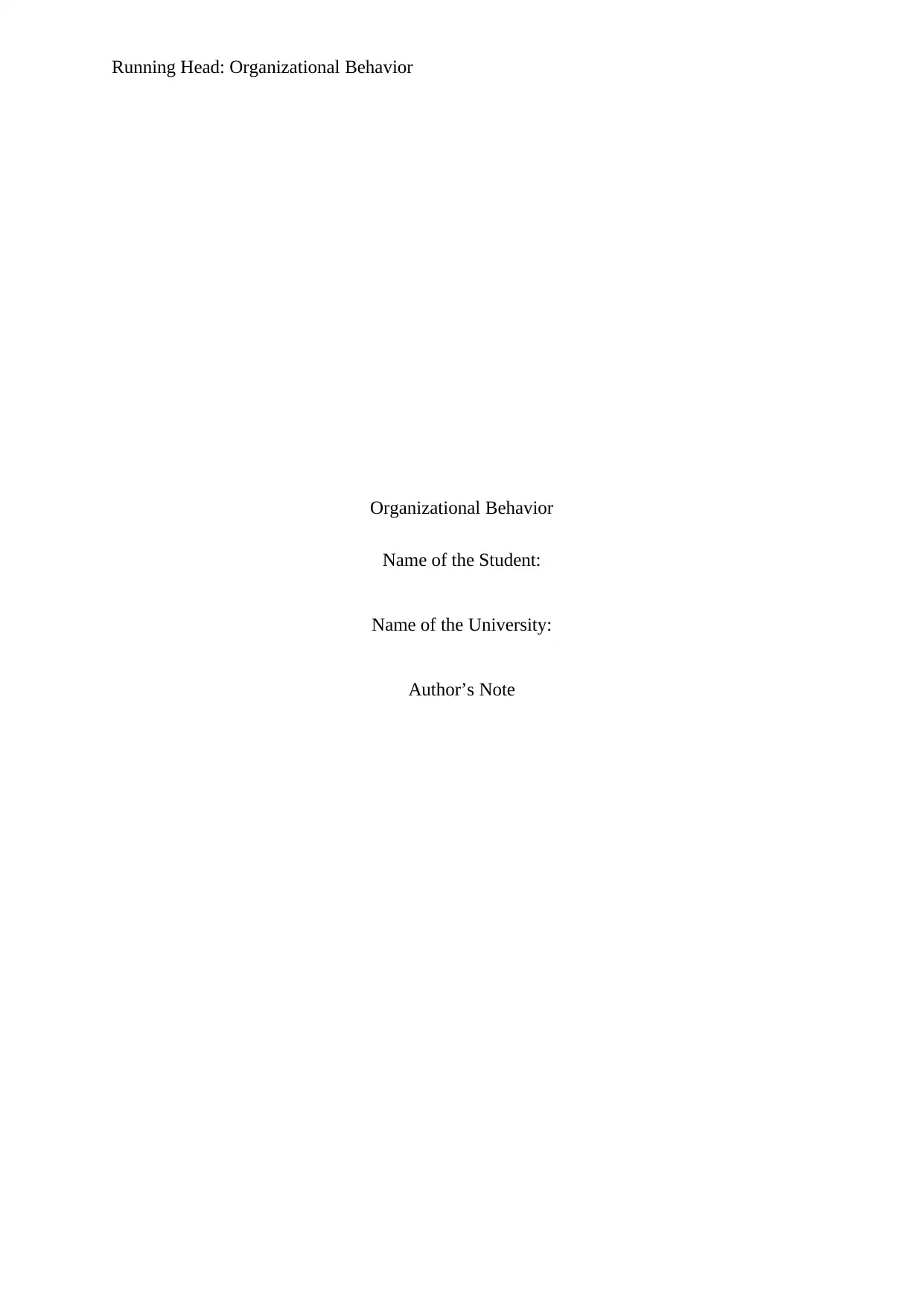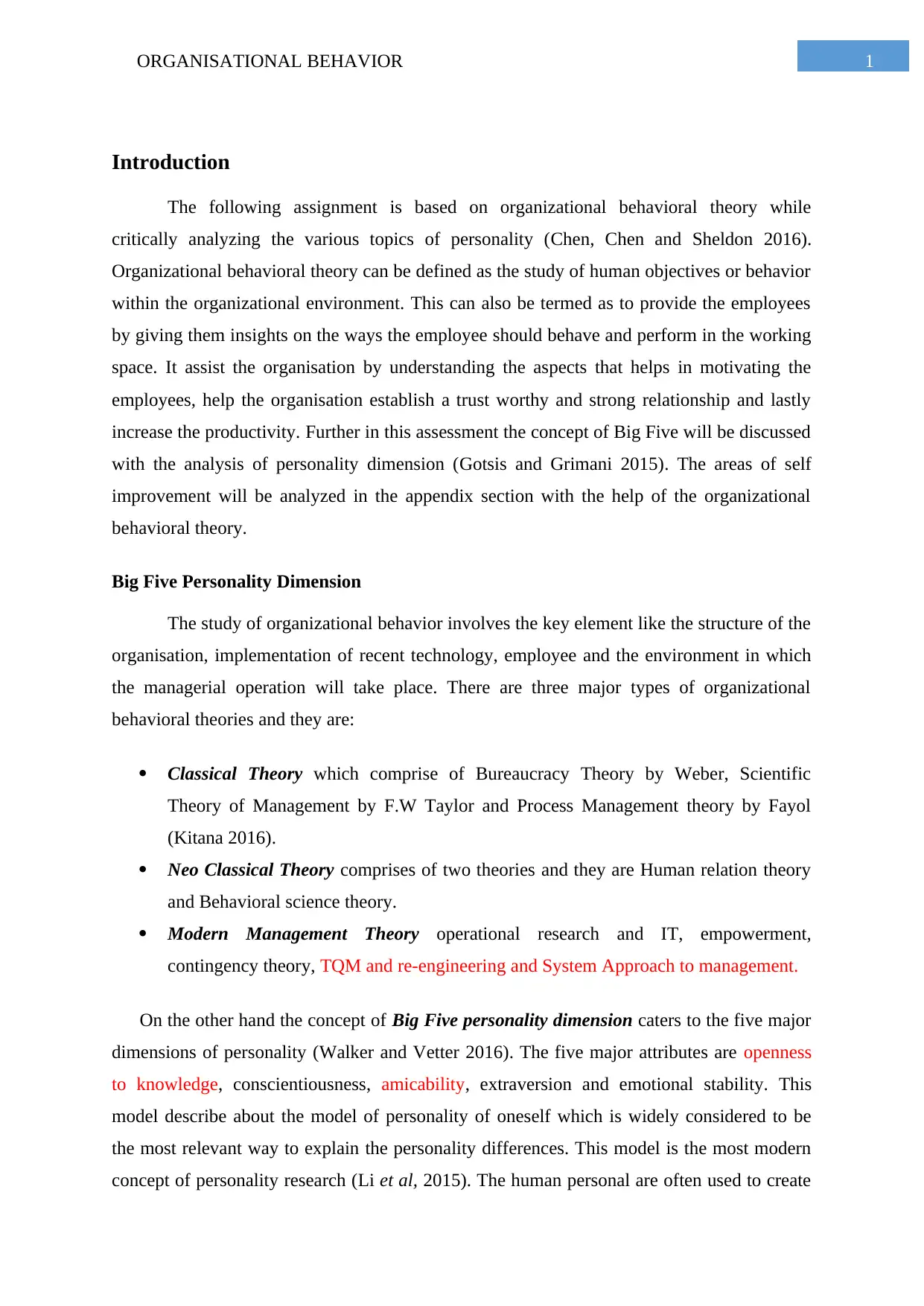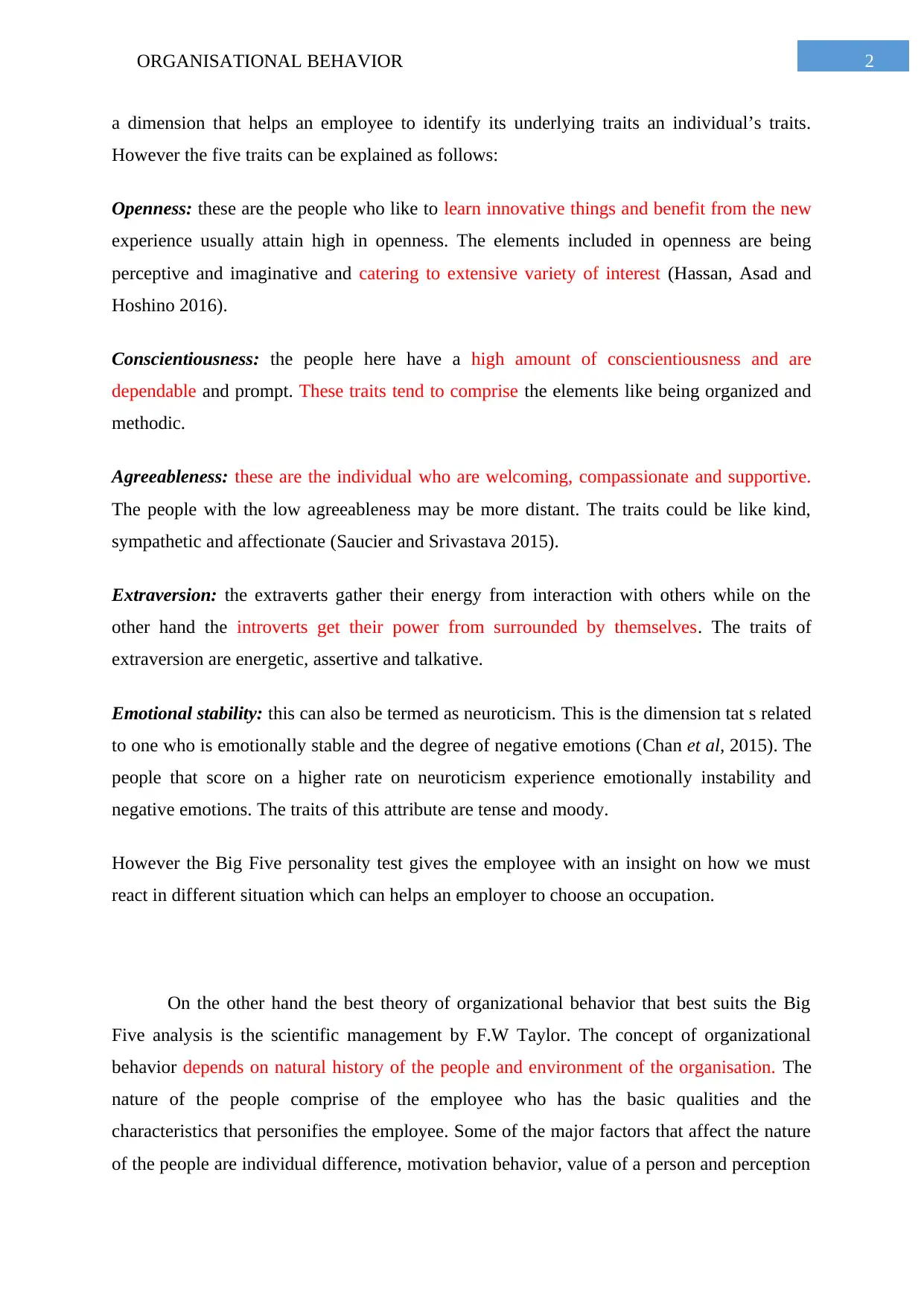Organisational Behaviour Assignment 2022
VerifiedAdded on 2022/09/12
|7
|1508
|22
Assignment
AI Summary
Contribute Materials
Your contribution can guide someone’s learning journey. Share your
documents today.

Running Head: Organizational Behavior
Organizational Behavior
Name of the Student:
Name of the University:
Author’s Note
Organizational Behavior
Name of the Student:
Name of the University:
Author’s Note
Secure Best Marks with AI Grader
Need help grading? Try our AI Grader for instant feedback on your assignments.

1ORGANISATIONAL BEHAVIOR
Introduction
The following assignment is based on organizational behavioral theory while
critically analyzing the various topics of personality (Chen, Chen and Sheldon 2016).
Organizational behavioral theory can be defined as the study of human objectives or behavior
within the organizational environment. This can also be termed as to provide the employees
by giving them insights on the ways the employee should behave and perform in the working
space. It assist the organisation by understanding the aspects that helps in motivating the
employees, help the organisation establish a trust worthy and strong relationship and lastly
increase the productivity. Further in this assessment the concept of Big Five will be discussed
with the analysis of personality dimension (Gotsis and Grimani 2015). The areas of self
improvement will be analyzed in the appendix section with the help of the organizational
behavioral theory.
Big Five Personality Dimension
The study of organizational behavior involves the key element like the structure of the
organisation, implementation of recent technology, employee and the environment in which
the managerial operation will take place. There are three major types of organizational
behavioral theories and they are:
Classical Theory which comprise of Bureaucracy Theory by Weber, Scientific
Theory of Management by F.W Taylor and Process Management theory by Fayol
(Kitana 2016).
Neo Classical Theory comprises of two theories and they are Human relation theory
and Behavioral science theory.
Modern Management Theory operational research and IT, empowerment,
contingency theory, TQM and re-engineering and System Approach to management.
On the other hand the concept of Big Five personality dimension caters to the five major
dimensions of personality (Walker and Vetter 2016). The five major attributes are openness
to knowledge, conscientiousness, amicability, extraversion and emotional stability. This
model describe about the model of personality of oneself which is widely considered to be
the most relevant way to explain the personality differences. This model is the most modern
concept of personality research (Li et al, 2015). The human personal are often used to create
Introduction
The following assignment is based on organizational behavioral theory while
critically analyzing the various topics of personality (Chen, Chen and Sheldon 2016).
Organizational behavioral theory can be defined as the study of human objectives or behavior
within the organizational environment. This can also be termed as to provide the employees
by giving them insights on the ways the employee should behave and perform in the working
space. It assist the organisation by understanding the aspects that helps in motivating the
employees, help the organisation establish a trust worthy and strong relationship and lastly
increase the productivity. Further in this assessment the concept of Big Five will be discussed
with the analysis of personality dimension (Gotsis and Grimani 2015). The areas of self
improvement will be analyzed in the appendix section with the help of the organizational
behavioral theory.
Big Five Personality Dimension
The study of organizational behavior involves the key element like the structure of the
organisation, implementation of recent technology, employee and the environment in which
the managerial operation will take place. There are three major types of organizational
behavioral theories and they are:
Classical Theory which comprise of Bureaucracy Theory by Weber, Scientific
Theory of Management by F.W Taylor and Process Management theory by Fayol
(Kitana 2016).
Neo Classical Theory comprises of two theories and they are Human relation theory
and Behavioral science theory.
Modern Management Theory operational research and IT, empowerment,
contingency theory, TQM and re-engineering and System Approach to management.
On the other hand the concept of Big Five personality dimension caters to the five major
dimensions of personality (Walker and Vetter 2016). The five major attributes are openness
to knowledge, conscientiousness, amicability, extraversion and emotional stability. This
model describe about the model of personality of oneself which is widely considered to be
the most relevant way to explain the personality differences. This model is the most modern
concept of personality research (Li et al, 2015). The human personal are often used to create

2ORGANISATIONAL BEHAVIOR
a dimension that helps an employee to identify its underlying traits an individual’s traits.
However the five traits can be explained as follows:
Openness: these are the people who like to learn innovative things and benefit from the new
experience usually attain high in openness. The elements included in openness are being
perceptive and imaginative and catering to extensive variety of interest (Hassan, Asad and
Hoshino 2016).
Conscientiousness: the people here have a high amount of conscientiousness and are
dependable and prompt. These traits tend to comprise the elements like being organized and
methodic.
Agreeableness: these are the individual who are welcoming, compassionate and supportive.
The people with the low agreeableness may be more distant. The traits could be like kind,
sympathetic and affectionate (Saucier and Srivastava 2015).
Extraversion: the extraverts gather their energy from interaction with others while on the
other hand the introverts get their power from surrounded by themselves. The traits of
extraversion are energetic, assertive and talkative.
Emotional stability: this can also be termed as neuroticism. This is the dimension tat s related
to one who is emotionally stable and the degree of negative emotions (Chan et al, 2015). The
people that score on a higher rate on neuroticism experience emotionally instability and
negative emotions. The traits of this attribute are tense and moody.
However the Big Five personality test gives the employee with an insight on how we must
react in different situation which can helps an employer to choose an occupation.
On the other hand the best theory of organizational behavior that best suits the Big
Five analysis is the scientific management by F.W Taylor. The concept of organizational
behavior depends on natural history of the people and environment of the organisation. The
nature of the people comprise of the employee who has the basic qualities and the
characteristics that personifies the employee. Some of the major factors that affect the nature
of the people are individual difference, motivation behavior, value of a person and perception
a dimension that helps an employee to identify its underlying traits an individual’s traits.
However the five traits can be explained as follows:
Openness: these are the people who like to learn innovative things and benefit from the new
experience usually attain high in openness. The elements included in openness are being
perceptive and imaginative and catering to extensive variety of interest (Hassan, Asad and
Hoshino 2016).
Conscientiousness: the people here have a high amount of conscientiousness and are
dependable and prompt. These traits tend to comprise the elements like being organized and
methodic.
Agreeableness: these are the individual who are welcoming, compassionate and supportive.
The people with the low agreeableness may be more distant. The traits could be like kind,
sympathetic and affectionate (Saucier and Srivastava 2015).
Extraversion: the extraverts gather their energy from interaction with others while on the
other hand the introverts get their power from surrounded by themselves. The traits of
extraversion are energetic, assertive and talkative.
Emotional stability: this can also be termed as neuroticism. This is the dimension tat s related
to one who is emotionally stable and the degree of negative emotions (Chan et al, 2015). The
people that score on a higher rate on neuroticism experience emotionally instability and
negative emotions. The traits of this attribute are tense and moody.
However the Big Five personality test gives the employee with an insight on how we must
react in different situation which can helps an employer to choose an occupation.
On the other hand the best theory of organizational behavior that best suits the Big
Five analysis is the scientific management by F.W Taylor. The concept of organizational
behavior depends on natural history of the people and environment of the organisation. The
nature of the people comprise of the employee who has the basic qualities and the
characteristics that personifies the employee. Some of the major factors that affect the nature
of the people are individual difference, motivation behavior, value of a person and perception

3ORGANISATIONAL BEHAVIOR
of the people. The second concept which is the nature of the organisation it holds the
responsibility of motivating the employee in the firm. It is the matter of opportunity that
provides the employee with a vision to work hard and held themselves as the reflection of a
company.
Utilization of the Big Five and Identify Performance Improvement Areas
Personality dimension Score Total
Openness: 5+10+15= 4+2+3 9
Conscientiousness: 3+8+13= 5+2+3 9
Extraversion: 1+6+11= 4+5+5 14
Agreeableness: 2+7+12=3+5+5 13
Emotional stability 4+9+14=2+3+5 10
The two areas of self-improvement areas that could be recognized from this theory are
openness and conscientiousness. Firstly in case of openness it is often observed that there the
employee prefer traditional sources and is less imaginative ideas, less scope of adapting
oneself from adapting the changes but there is little scope for new environment or little scope
in case of meeting new people (Kayiş et al, 2016). Hence it can be improved by building the
imaginative ideas so that the employee can bring in innovation in the organisation and can
cover a range of interest while mixing themselves to all sorts of situation. Lastly the second
filed of improvement is the conscientiousness as there is lack in reliability scope of other and
is not focused on the goals. If the employee improves these area of conscientiousness he or
she will be able to be more responsible, will various agendas of the organization and will be
less dependable and lastly will be determined towards the objective of the organisation and
achieve its goals.
of the people. The second concept which is the nature of the organisation it holds the
responsibility of motivating the employee in the firm. It is the matter of opportunity that
provides the employee with a vision to work hard and held themselves as the reflection of a
company.
Utilization of the Big Five and Identify Performance Improvement Areas
Personality dimension Score Total
Openness: 5+10+15= 4+2+3 9
Conscientiousness: 3+8+13= 5+2+3 9
Extraversion: 1+6+11= 4+5+5 14
Agreeableness: 2+7+12=3+5+5 13
Emotional stability 4+9+14=2+3+5 10
The two areas of self-improvement areas that could be recognized from this theory are
openness and conscientiousness. Firstly in case of openness it is often observed that there the
employee prefer traditional sources and is less imaginative ideas, less scope of adapting
oneself from adapting the changes but there is little scope for new environment or little scope
in case of meeting new people (Kayiş et al, 2016). Hence it can be improved by building the
imaginative ideas so that the employee can bring in innovation in the organisation and can
cover a range of interest while mixing themselves to all sorts of situation. Lastly the second
filed of improvement is the conscientiousness as there is lack in reliability scope of other and
is not focused on the goals. If the employee improves these area of conscientiousness he or
she will be able to be more responsible, will various agendas of the organization and will be
less dependable and lastly will be determined towards the objective of the organisation and
achieve its goals.
Secure Best Marks with AI Grader
Need help grading? Try our AI Grader for instant feedback on your assignments.

4ORGANISATIONAL BEHAVIOR
Conclusion
Hence it can be recommended that the organizational behavioral theory and
personality dimension theory which is the theory of Scientific Management by F.W Taylor
and the Big Five Personality Dimension states the importance of an employee in regards to
their behavior within the organisation. The big five assessment had assisted to cater the areas
of improvement and hence kit will help the employee to rectify its mistake and work on them
so that they become a reflection of the company. The Five Factor Model is well designed and
assists in accepting of the interrelation among the culture and personality through analyzing
the leading paradigm for individuality assessment.
Conclusion
Hence it can be recommended that the organizational behavioral theory and
personality dimension theory which is the theory of Scientific Management by F.W Taylor
and the Big Five Personality Dimension states the importance of an employee in regards to
their behavior within the organisation. The big five assessment had assisted to cater the areas
of improvement and hence kit will help the employee to rectify its mistake and work on them
so that they become a reflection of the company. The Five Factor Model is well designed and
assists in accepting of the interrelation among the culture and personality through analyzing
the leading paradigm for individuality assessment.

5ORGANISATIONAL BEHAVIOR
Reference
Chan, K.Y., Uy, M.A., Chernyshenko, O.S., Ho, M.H.R. and Sam, Y.L., 2015. Personality
and entrepreneurial, professional and leadership motivations. Personality and individual
differences, 77, pp.161-166.
Chen, M., Chen, C.C. and Sheldon, O.J., 2016. Relaxing moral reasoning to win: How
organizational identification relates to unethical pro-organizational behavior. Journal of
Applied Psychology, 101(8), p.1082.
Gotsis, G. and Grimani, K., 2015. Virtue theory and organizational behavior: an integrative
framework. Journal of Management Development.
Hassan, H., Asad, S. and Hoshino, Y., 2016. Determinants of leadership style in big five
personality dimensions. universal journal of management, 4(4), pp.161-179.
Kayiş, A.R., Satici, S.A., Yilmaz, M.F., Şimşek, D., Ceyhan, E. and Bakioğlu, F., 2016. Big
five-personality trait and internet addiction: A meta-analytic review. Computers in Human
Behavior, 63, pp.35-40.
Kitana, A., 2016. Overview of the managerial thoughts and theories from the history:
classical management theory to modern management theory. Indian Journal of Management
Science, 6(1), p.16.
Li, Y., Guan, Y., Wang, F., Zhou, X., Guo, K., Jiang, P., Mo, Z., Li, Y. and Fang, Z., 2015.
Big-five personality and BIS/BAS traits as predictors of career exploration: The mediation
role of career adaptability. Journal of Vocational Behavior, 89, pp.39-45.
Saucier, G. and Srivastava, S., 2015. What makes a good structural model of personality?
Evaluating the big five and alternatives.
Walker, M. and Vetter, T., 2016. Changing the personality of a face: Perceived Big Two and
Big Five personality factors modeled in real photographs. Journal of personality and social
psychology, 110(4), p.609.
Reference
Chan, K.Y., Uy, M.A., Chernyshenko, O.S., Ho, M.H.R. and Sam, Y.L., 2015. Personality
and entrepreneurial, professional and leadership motivations. Personality and individual
differences, 77, pp.161-166.
Chen, M., Chen, C.C. and Sheldon, O.J., 2016. Relaxing moral reasoning to win: How
organizational identification relates to unethical pro-organizational behavior. Journal of
Applied Psychology, 101(8), p.1082.
Gotsis, G. and Grimani, K., 2015. Virtue theory and organizational behavior: an integrative
framework. Journal of Management Development.
Hassan, H., Asad, S. and Hoshino, Y., 2016. Determinants of leadership style in big five
personality dimensions. universal journal of management, 4(4), pp.161-179.
Kayiş, A.R., Satici, S.A., Yilmaz, M.F., Şimşek, D., Ceyhan, E. and Bakioğlu, F., 2016. Big
five-personality trait and internet addiction: A meta-analytic review. Computers in Human
Behavior, 63, pp.35-40.
Kitana, A., 2016. Overview of the managerial thoughts and theories from the history:
classical management theory to modern management theory. Indian Journal of Management
Science, 6(1), p.16.
Li, Y., Guan, Y., Wang, F., Zhou, X., Guo, K., Jiang, P., Mo, Z., Li, Y. and Fang, Z., 2015.
Big-five personality and BIS/BAS traits as predictors of career exploration: The mediation
role of career adaptability. Journal of Vocational Behavior, 89, pp.39-45.
Saucier, G. and Srivastava, S., 2015. What makes a good structural model of personality?
Evaluating the big five and alternatives.
Walker, M. and Vetter, T., 2016. Changing the personality of a face: Perceived Big Two and
Big Five personality factors modeled in real photographs. Journal of personality and social
psychology, 110(4), p.609.

6ORGANISATIONAL BEHAVIOR
1 out of 7
Related Documents
Your All-in-One AI-Powered Toolkit for Academic Success.
+13062052269
info@desklib.com
Available 24*7 on WhatsApp / Email
![[object Object]](/_next/static/media/star-bottom.7253800d.svg)
Unlock your academic potential
© 2024 | Zucol Services PVT LTD | All rights reserved.





